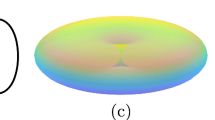Abstract
We consider a recently introduced new finite element approach for the discretization of elliptic partial differential equations on surfaces. The main idea of this method is to use finite element spaces that are induced by triangulations of an “outer” domain to discretize the partial differential equation on the surface. The method is particularly suitable for problems in which there is a coupling with a problem in an outer domain that contains the surface, for example, two-phase flow problems. It has been proved that the method has optimal order of convergence both in the H 1 and in the L 2-norm. In this paper, we address linear algebra aspects of this new finite element method. In particular the conditioning of the mass and stiffness matrix is investigated. For the two-dimensional case we present an analysis which proves that the (effective) spectral condition number of the diagonally scaled mass matrix and the diagonally scaled stiffness matrix behaves like h −3| ln h| and h −2| ln h|, respectively, where h is the mesh size of the outer triangulation.
Similar content being viewed by others
References
Braess D.: Finite Elements: Theory, Fast Solvers, and Applications in Solid Mechanics, 3rd edn. Cambridge University Press, London (2007)
Deckelnick, K., Dziuk, G., Elliott, C.M., Heine, C.-J.: An h-narrow band finite element method for elliptic equations on implicit surfaces. IMA J. Numer. Anal., doi:10.1093/imanum/drn049 (2009)
Demlow A., Dziuk G.: An adaptive finite element method for the Laplace–Beltrami operator on implicitly defined surfaces. SIAM J. Numer. Anal. 45, 421–442 (2007)
DROPS package. http://www.igpm.rwth-aachen.de/DROPS/
Dziuk G.: Finite elements for the beltrami operator on arbitrary surfaces. In: Hildebrandt, S., Leis, R. (eds) Partial Differential Equations and Calculus of Variations. Lecture Notes in Mathematics, vol. 1357, pp. 142–155. Springer, Heidelberg (1988)
James A., Lowengrub J.: A surfactant-conserving volume-of-fluid method for interfacial flows with insoluble surfactant. J. Comp. Phys. 201, 685–722 (2004)
Muradoglu M., Tryggvason G.: A front-tracking method for computation of interfacial flows with soluble surfactant. J. Comput. Phys. 227, 2238–2262 (2008)
Olshanskii, M.A., Reusken, A.: A finite element method for surface PDEs: Matrix properties, Preprint 287, IGPM, RWTH Aachen, earlier version of this paper (2008)
Olshanskii, M.A., Reusken, A., Grande, J.: An eulerian finite element method for elliptic equations on moving surfaces. Accepted to SIAM J. Numer. Anal. (2009)
Author information
Authors and Affiliations
Corresponding author
Additional information
Partially supported by the the Russian Foundation for Basic Research through the projects 08-01-00159 and 09-01-00115. This work was supported by the German Research Foundation through SFB 540.
Rights and permissions
About this article
Cite this article
Olshanskii, M.A., Reusken, A. A finite element method for surface PDEs: matrix properties. Numer. Math. 114, 491–520 (2010). https://doi.org/10.1007/s00211-009-0260-4
Received:
Revised:
Published:
Issue Date:
DOI: https://doi.org/10.1007/s00211-009-0260-4




